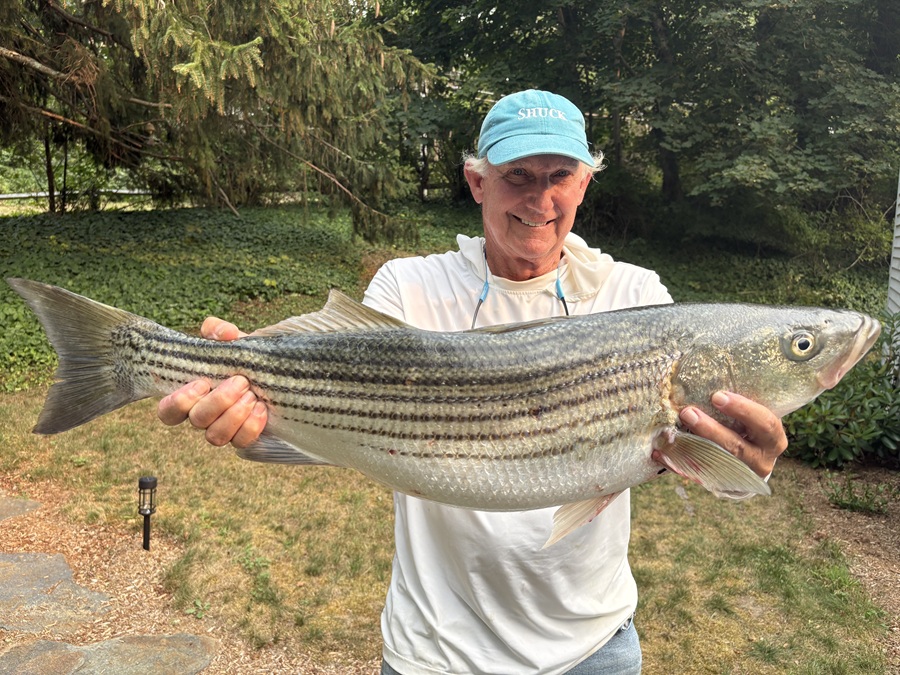It’s been an odd year, to say the least. By my count, we’ve had more days this summer with winds out of the north and east than days with our typical summer westerlies and winds from the south. My tomato plants still look like they did in mid-June, and the extraordinary, uplifting spring honey locust bloom of June has been replaced by eerie midday palls and apocalyptic sunsets from the Canadian forest fires of August. Beach fishing has been virtually nonexistent.
Blame for all of this, particularly the poor beach fishing, can’t be the lack of our usual Bermuda highs or a sudden shift in ocean currents. It’s not that the fish aren’t here, it’s that they show up and then disappear just as quickly, making predictability impossible.
Even when you find the fish, though, there’s been no guarantee of catching them. A half dozen times this summer, my pal Ted Kurland and I have set out in his boat from Pamet Harbor looking for bass and blues on expeditions that have required far larger investments of time and gasoline than they have in previous summers. Gathering fish intel from friends, harbormasters, guides, and tackle shops, we felt like we were playing pin-the-tail-on-the-striper. Suggestions have pointed us everywhere from Billingsgate to Beach Point, from Wood End to the Race Point Lighthouse, and out to Stellwagen Bank.
While Ted’s 19-foot Brady-White is equipped with a new fishfinder, we’ve done better the old-fashioned way: moving fast and looking for birds. On more than half of our outings, we followed the birds, only to find that the fish under them were absolutely apathetic about our usual array of lures.

Part of the problem was that each school we encountered included both bluefish and bass. While the latter is famous for its pickiness, bluefish are universally loved by fishermen for their willingness to hit pretty much any lure in the tacklebox.
Being hard-headed helped, as it took a bit of time to figure out how to hook these astonishingly uninterested fish. On our very first encounter with them, I tried every popper I owned before realizing the reason Ted had hooked both a blue and a striper was that he had switched over to a small-leaded silicon-tail lure.
The mixed schools retaught me something I’d learned as a young fisherman. When my pals and I got sick of catching bluefish, we would toss shiny metal lures beyond the rampaging blues. By letting them sink a bit before starting a slow retrieve, we’d catch the big bass that follow every bluefish blitz, silently dining on pieces of mauled baitfish floating down from the combat zone.
It seems clear that this summer’s fishing frustrations have had more to do with the question of bait, or lack of it, than with fish being confused by weird weather or sudden changes in water temperature. Except for mackerel, there has been a dramatic dearth of larger baitfish this summer.
After making a very short appearance in early May, the large schools of menhaden that are nearly always found in Cape Cod’s harbors and on our beaches have been summer no-shows. This has been equally true for peanut bunker, the juvenile form of menhaden and another favorite food for predator species.
The Cape’s ubiquitous sand eel, every fish and bird’s favorite menu item, is in abundance this summer, but it’s predominantly in juvenile form. The baitfish the bass and blues are feeding on, even in the blitzes we’ve seen, are so tiny they have been nearly impossible to identify until we’re back on shore cleaning the fish. Mostly I’ve found small sand eels, though several of the fish I filleted had bellies full of tiny silversides.
All summer, I worried about the strange disappearance of menhaden from Cape Cod Bay. I had emailed a marine biologist at the Atlantic States Marine Fisheries Council to learn more about their vanishing act and was anxiously awaiting a callback when Ted and I made our most recent expedition a week or so ago.
We found ourselves in a massive blitz off Race Point, and since I’d changed out my popper for a small sinking silicon lure before making my first cast, I was rewarded by landing a fat, hard-fighting bass as soon as we arrived under the birds. It was a beautiful day, and what little breeze we’d had earlier in the day vanished completely as we sped home over the mirror-like bay.
Then, just a bit more than halfway across the bay, I saw what I first thought were cat’s paws — imprints of wind riffling the surface. I asked Ted to slow down, and as the boat began to drift it dawned on us that the dark patches of vibrating water that extended as far as we could see were the unmistakable indicators of menhaden on the move.
It was a heartwarming sight, and as the orange sun drifted toward yet another smoke-tinged sunset, Ted and I exchanged the kind of smiles we might have on a beautiful day at the very start of a typical summer.



